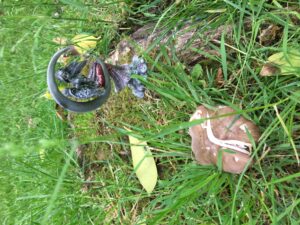Wales is a land rich in mythology and here Alexandra Walsh explains how she researched and applied some of it to her latest novel.
In The Wind Chime, my main character Amelia Prentice is sent on a quest by her dying mother, Joan. Requesting Amelia should tidy the attic of their family home before she made any decisions about selling it, Amelia discovers a box of Victorian photographs, with a hand-drawn family tree. The annotations on the back of the images names them as the Attwater family from Cliffside in Pembrokeshire.
Amelia has never heard this name before but she is intrigued by the family and is drawn to the youngest daughter, Osyth Attwater. When she discovers Osyth’s journal among her mother’s papers, she feels compelled to visit Cliffside and find out more.
The Mythology
 At night, the Attwater family of old would gather on their veranda, listening to the wind chime and watching the sun set into the roaring ocean. They told each other stories and Osyth revelled in the tales her Uncle Noah wove around them, using them as a guide to her life.
At night, the Attwater family of old would gather on their veranda, listening to the wind chime and watching the sun set into the roaring ocean. They told each other stories and Osyth revelled in the tales her Uncle Noah wove around them, using them as a guide to her life.
In order to make to create Osyth’s interior life, I drew on tales far and wide. These included old fairy stories, local legends and Celtic mythology. At the beginning of the book, Osyth is in her late teens and is letting go of her childhood as she enters the adult world, yet she cannot fully abandon the magical world of her childhood. Throughout, I was aware the tales needed to fit in with Osyth’s story rather than distracting from it, so the fairies invited to join the party were chosen with great care.
Tylwyth Teg was the most important tale. This is the Welsh translation for the Fair Folk or Fairy Folk and their magical home can take a number of forms, from the underground land reached through the doorways of the Celtic stone circles or in mysterious green lands that can be glimpsed off the Welsh coast. Osyth is fascinated with Tylwyth Teg and it is from here she draws on other magical creatures who are her talismans and protectors as she discovers bitter family secrets.
 It is during the celebrations of a family wedding, Osyth’s aunt, Hannah, tells the story of how the world of the Fair Folk was created. It is the tale of a woman who hid her children from Jesus when he visited her home as she was ashamed of her fecundity. However, when she searched for her family later, there was no sign of her children. She was told God had taken them as a punishment for hiding the gifts he had bestowed upon her. In the legend, these children were taken underground and became the ancestors of all the creatures in the Land of Tylwyth Teg.
It is during the celebrations of a family wedding, Osyth’s aunt, Hannah, tells the story of how the world of the Fair Folk was created. It is the tale of a woman who hid her children from Jesus when he visited her home as she was ashamed of her fecundity. However, when she searched for her family later, there was no sign of her children. She was told God had taken them as a punishment for hiding the gifts he had bestowed upon her. In the legend, these children were taken underground and became the ancestors of all the creatures in the Land of Tylwyth Teg.
While dressing for this wedding, Osyth references Gwenhwyfar, the fairy of the White Moon Shadows. This fairy dances through the world leaving tiny white flowers in her wake. White flowers became a theme throughout the story, including the name of her perfume, White Rose, from the perfumiers, Floris.
The most interesting creature I discovered was the gwrach-y-rhibyn, the witch of death from Welsh mythology. This terrifying creature with her red eyes, green-tinged skin and dark leathery wings, gathered the souls of the dead and would visit houses whenever a death was imminent. It calls to mind the Irish banshee, which considering the close proximity of the two coastlines is unsurprising.
I hope this small insight into the fairies and their world will make your reading of The Wind Chime – and Welsh mythology – more interesting.

